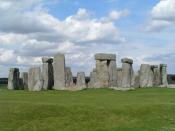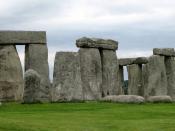Stonehenge is a huge megalithic monument situated on Salisbury Plain, Mid-Wiltshire, England. The ruins of Stonehenge contain stones from three stages of building. These stages took place over a period of roughly 1600 years from 3100 BC to 1500 BC (Chippindale, 1983:271). Stonehenge has been severely damaged by things as different as tourists to weather. What it is today is quite different from what scientists suggest it may have looked like when it was finished (Fig1 and Fig2). Since Stonehenge was built long before recorded history it has brought forth great suspicion and curiosity. Who built Stonehenge and why was it built? These two questions have been argued for hundreds of years since Stonehenge was rediscovered from a three thousand year rest after its abandonment. Numerous theories have arisen over who built Stonehenge including the Druids and Merlin, and about what it was built for such as a calendar, an observatory and a ritual burial ground.
My theory, however, is that Stonehenge was built by Early Britons for religious purposes.
Some of the theories about why Stonehenge was built are not supported by substantial evidence. However, even theories about Stonehenge that have been proven false, still flourish (Chippindale, 1983; 263). The suggestion that Stonehenge was built as a burial ground is clearly questionable. Although there are many burials around the site of Stonehenge, this is because Stonehenge started as a burial site, but from stage two onwards its purpose was changed (Merkur, 1990:24). Similarly there is also no evidence to support the theory that it was used for sacrificial purposes (Anon, 2001;np). This is clear since the altar stone on to which this theory is based shows no traces of blood stains or marks from sacrificial knifes. The theory Stonehenge was built as a calendar or an observatory...


